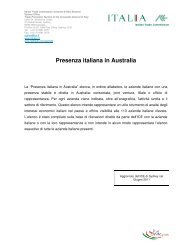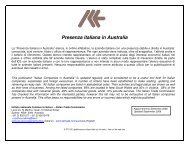Price Determination in the Australian Food Industry A Report
Price Determination in the Australian Food Industry A Report
Price Determination in the Australian Food Industry A Report
Create successful ePaper yourself
Turn your PDF publications into a flip-book with our unique Google optimized e-Paper software.
Farmgate prices<br />
Farmgate prices are determ<strong>in</strong>ed accord<strong>in</strong>g to <strong>the</strong> prevail<strong>in</strong>g returns from <strong>the</strong> total market available<br />
to <strong>the</strong> <strong>in</strong>dustry – a mix of export and domestic returns – as outl<strong>in</strong>ed on pages 33–34 <strong>in</strong> Dairy – how<br />
are farmgate milk prices set?<br />
The major participants <strong>in</strong> <strong>the</strong> dairy <strong>in</strong>dustry do not differentiate between <strong>the</strong> various end uses of<br />
milk when sett<strong>in</strong>g prices at <strong>the</strong> farmgate.<br />
The vast majority of cheese manufacture is owned by cooperatives, and milk pric<strong>in</strong>g offered by<br />
such companies will tend to be weighted average prices that are payable from returns on a range<br />
of dairy products from export and domestic markets.<br />
As cheddar cheese is a storable commodity dairy product, cheese-mak<strong>in</strong>g cooperatives like to take<br />
advantage of lower cost seasonal milk production systems. This sees much of <strong>the</strong> output<br />
generated <strong>in</strong> <strong>the</strong> spr<strong>in</strong>g and summer months of <strong>the</strong> year. It is none<strong>the</strong>less more efficient and<br />
profitable for an operation to be <strong>in</strong> production for most if not all of <strong>the</strong> year <strong>in</strong> order to spread fixed<br />
overhead costs over higher volumes of product.<br />
Milk prices are accord<strong>in</strong>gly structured to manage <strong>the</strong> flows of milk dur<strong>in</strong>g <strong>the</strong> year by offer<strong>in</strong>g<br />
<strong>in</strong>centives which promote higher production of milk <strong>in</strong> months when grass-fed production is most<br />
difficult. <strong>Price</strong>s conta<strong>in</strong> <strong>in</strong>centives to also promote optimum composition of butterfat and prote<strong>in</strong>.<br />
The retail–farmgate spread<br />
Straightforward comparisons of cheese product prices and farmgate returns are overly simplistic:<br />
cheese is produced us<strong>in</strong>g butterfat and prote<strong>in</strong> <strong>in</strong>gredients which are separately valued <strong>in</strong> milk<br />
pric<strong>in</strong>g formulas offered by dairy companies.<br />
Dairy – analysis of pric<strong>in</strong>g of dairy spreads, pages 30–32, describes <strong>the</strong> factors taken <strong>in</strong>to account<br />
<strong>in</strong> <strong>the</strong> pric<strong>in</strong>g of farmgate milk.<br />
The chart below depicts <strong>the</strong> spread of retail and farmgate prices that are relevant to <strong>the</strong> two majorsell<strong>in</strong>g<br />
cheese l<strong>in</strong>es. The retail price data presented <strong>in</strong> <strong>the</strong> chart <strong>in</strong>cludes <strong>the</strong> weighted average of<br />
supermarket sales data for 500g and 1kg packs of mature cheddar cheese. This is compared to <strong>the</strong><br />
average farmgate price paid by major manufactur<strong>in</strong>g companies <strong>in</strong> <strong>the</strong> past six years.<br />
<strong>Price</strong> <strong>Determ<strong>in</strong>ation</strong> <strong>in</strong> <strong>the</strong> <strong>Australian</strong> <strong>Food</strong> <strong>Industry</strong> A <strong>Report</strong><br />
28<br />
Figure 20. Retail versus farmgate cheddar cheese prices, $/litre equivalent nom<strong>in</strong>al<br />
amounts, 1998–2003<br />
$<br />
0.80<br />
0.70<br />
0.60<br />
0.50<br />
0.40<br />
0.30<br />
0.20<br />
0.10<br />
0<br />
retail equivalent<br />
Source: Dairy Australia and Whitehall Associates<br />
farmgate<br />
Jan 1998 Jan 2003<br />
Note: This chart is based on <strong>the</strong> follow<strong>in</strong>g:<br />
• weighted average monthly data from cha<strong>in</strong> retail over six years comb<strong>in</strong><strong>in</strong>g 500g and 1kg cheddar<br />
cheese blocks;<br />
• average manufactur<strong>in</strong>g rates for milk used by Victorian manufactur<strong>in</strong>g companies over <strong>the</strong> six<br />
years to June 2003; and<br />
• conversion of milk <strong>in</strong>to cheddar cheese at <strong>the</strong> yield of 9.88 litres per kg cheese.







